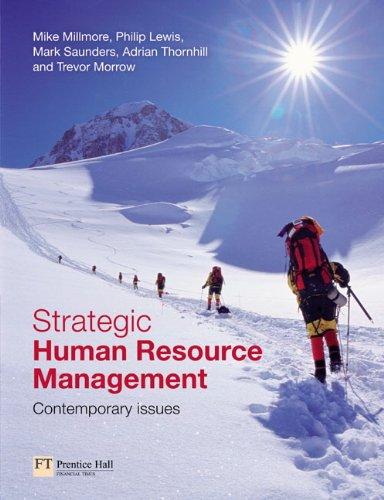The Tibbett and Britten Group (TBG) is a UK-based international logistics service provider. Its main customers are
Question:
The Tibbett and Britten Group (TBG) is a UK-based international logistics service provider. Its main customers are retailers and manufacturers, to whom it provides warehouse, distribution and supply-chain management services under long-term contracts.
The company directly employs 35,000 people in 35 countries, with the biggest markets in Europe and North America.
TBG employs people on a variety of contracts in different countries. Operating in a highly competitive sector, margins are low and the penalty to the business of passing on sudden rises in employment costs to customers is high. This is especially true where contracts are operated on an ‘open book’ basis, whereby a management fee is charged and other costs are agreed with the customer. The company’s objective was, therefore, to reform group reward policy in a way that would be largely cost-neutral. Between 65 per cent and 70 per cent of the Group’s overall operational costs relate directly to people, so staff reward management is key to business competitiveness.
The majority of TBG’s employees were transferred from major customers such as Debenhams, Homebase or IBM. These employees retained their existing terms and conditions of employment. This meant that there was a wide variety of pay and grading arrangements in operation. These varied by country and contract. There were short- and long-term incentives and other benefits. There were also differing local relationships with trade unions. Local managers had traditionally agreed to vary certain arrangements locally and to pay upper quartile rates, for instance, or to use a particular form of competence-based pay.
While the use of TBG incentives and benefits had become more consistent, many contracts were determined by the terms and conditions transferred from the customer. Most non-management employees were not on TBG terms and conditions. Managing this complexity was a key issue in the company’s relationships with both employees and customers.
Developing a new strategy The group started the process of reviewing its pay and benefits arrangements in 2002. The company had grown rapidly but there had been no attempt to introduce consistency in the way that managers in different countries were rewarded. The UK grading structure had been identified as an issue in need of attention, but it was felt that the best way to approach the problem was to take a step back and put a broader framework for reward in place across the company. The objectives were to:
• bring a measure of internal consistency to reward by establishing a group policy framework that would:
• help managers communicate a coherent policy on reward;
• guide country managers in the alignment of reward policies and projects within overall group principles;
• initiate a cost-effectiveness review of current reward expenditure in light of what was identified as valued by employees; and • maintain the flexibility for local innovation and adaptability to customers’ needs;
• address tactical issues impacting negatively on employee motivation and engagement, and create a culture where performance drove reward and recognition;
• create competitive advantage for TBG in the market place, particularly by improving its reputation as a contractor and employer of choice.
The key elements of the reward project were to:
• introduce a broad strategy focused on ten reward principles;
• review all elements of reward in line with these principles, project by project;
• move from the current grading structure to a new job level and job family structure, with five broad work levels, to be rolled out first in the UK; and • continue to roll out a new voluntary benefits programme as part of the strategy, introduced in the UK in September 2003, to European countries.
TBG focused on a population of around 3,000 managers in developing the new reward strategy and introducing the new job levels. The approach was ‘one step at a time’.
The overall reward strategy had been developed using focus groups, interviews with managers, and extensive organisational analysis conducted by the HR team............
Questions
1. Why do you think that the creation of internal consistency was such an important objective of the new reward strategy?
2. Look again at the ten principles. Do you think there may be any potential contradictions inherent in these principles?
3. What potential benefits do you think may accompany the achievement of greater transparency in the new reward strategy?
Step by Step Answer:

Strategic Human Resource Management Contemporary Issues
ISBN: 9780273681632
1st Edition
Authors: Mark N. K. Saunders; Mike Millmore; Philip Lewis; Adrian Thornhill; Trevor Morrow





